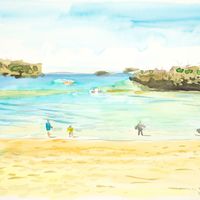Okinawa 沖繩
Item
-
Title
-
Okinawa 沖繩
-
Creator
-
Professor Hui Cheuk Kuen, Desmond (許焯權教授)
-
Description
-
This sketch was done on Manza Beach near the famous tourist landmark Cape Manzamo, the elephant trunk-shaped scenic rock formation named by the 18th Century Ryukyuan King Sho Kei, who sought to express the idea that the rock was large enough to seat 10,000 people. The Kanji characters of the Japanese name Man-za-mo literally mean ‘10,000-seat-field’. An even more interesting example of this crossing of Ryukyuan, Chinese and Japanese culture is the Shuri Castle in Naha, the seat of the Ryukyu Kingdom since the 14th Century. The castle has been destroyed and rebuilt several times over the centuries, and a fire in October 2019 again razed its main structure, giving rise to yet another version of this cross-cultural interpretation of architectural heritage for the future.
沖繩的多樣化身份要親身到當地才能感受 - 看到及體驗琉球文化如何與中國及日本文化追源溯流。這幅速寫是在著名旅遊景點萬座毛附近的萬座海灘繪畫的,萬座毛是一處天然形成貌似象鼻的海岸岩石,名字是十八世紀琉球王尚 敬所取,形容岩石的頂部平坦寬闊,可以容納一萬人坐下來。故此日文的名字用了三個漢字,正正就是這個意思。當然另一個結合了琉球、中國和日本文化的更有趣的例子是那霸的首里城,這是自十四世紀以來琉球王國的中心,曾經歷了多次的毀滅與重建。2019年十月首里城被火災燒掉了大部分主要的建築,再一次讓沖繩人民對這座建築文物作新的跨文化演繹。
-
Date Created
-
October 21, 2019
-
Spatial Coverage
-
Okinawa, Japan
-
Coloration
-
Multicolored
-
Genre/Form
-
Watercolors
 28_Okinawa.jpg
28_Okinawa.jpg
